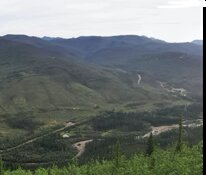Lawrence Roulston: There are so many variables impacting the gold price that it's really hard to make short-term predictions. My approach is to recognize the long-term strength in the gold market, and then use short-term corrections as buying opportunities.
I focus on companies involved in the gold sector rather than looking at the bullion market directly. Exploration and development (E&D) companies will gain from that long-term strength in the gold market. The companies that are successful at advancing their projects are going to generate gains for shareholders that are far greater than the short-term moves in the metal prices. Let me explain, the recent dip in the gold price is around 5%. But the stocks of several companies we follow have gained 50% during that time. Those big gains are based on advancing the projects and meeting milestones along the exploration cycle.
TGR: What other advice would you give to gold investors?
LR: There is tremendous upside in the gold market. If an investor is hoping to profit by day trading bullion or gold stocks, I'm not really the person to help in that regard. I believe there is enormous strength in the market for investors who are looking at the bigger, long-term picture.
The paper currencies in the world are on a downward path. There has been evidence of that for a decade, and there is evidence that it is most likely going to continue. For example, investors in Europe are becoming nervous about the euro and they're turning to gold. I believe that trend was a major component in the increase of the gold price last year. I believe that trend will continue over the long term as concerns about the euro and other currencies spread to other parts of the world. Gold is becoming more important now as a hard asset to protect value in the long term.
TGR: Do you spend a lot of time looking at the macro level, such as issues with inflation in China?
LR: I spend a fair amount of time monitoring what's going on in the world. I spend a lot of time traveling, and I spend a lot of time in China. Last fall, I was in four other Asian countries. I've been to Europe twice in just the last several months. A major purpose of this travel is to keep tabs on the pulse of the market. I'm very concerned with a number of variables that are going to impact currencies and that could be supportive of the gold market in the long term.
TGR: Do you build financial models on the companies you are researching?
LR: I have years of experience building very sophisticated models. But models are not that effective for early stage companies. It's more a matter of judgment and experience than it is of trying to reduce things to simplistic numbers.
TGR: Indeed. It's difficult to develop a proper model without revenue. You follow mining plays in Colombia and Guyana and track what's going on in old camps like the Yukon and Alaska. Would you rather be in a new play in an old camp or a new play in a new camp?
LR: I definitely would rather be in a new play in an old camp. A tremendous amount of exploration work was done all around the world over several decades. Areas like the Yukon and Alaska saw a lot of really good work done by major companies and juniors, as well as prospectors. Building on that historic information is far more beneficial than is starting from scratch. Perhaps the recent discoveries in the Yukon are not based directly on work that was done previously, but that earlier work provided a geological context that was a basis for the new discoveries. There's always a huge benefit in building on work that was done previously.
TGR: Are you following some companies with promising mineral development projects in Alaska?
LR: I'm following several companies in Alaska. Alaska hasn't had the really big promotional effort behind it that the Yukon has experienced, but there's been a lot of success there. Two of the success stories are Northern Dynasty Minerals Ltd. (NYSE.A:NAK; TSX:NDM) and NovaGold Resources Inc. (NYSE.A:NG; TSX:NG). Both companies have seen huge increases in their share prices over the last few months.
There are also a number of earlier stage companies in Alaska, such as International Tower Hill Mines Ltd. (TSX:ITH; NYSE.A:THM) and Millrock Resources Inc. (TSX.V:MRO). The team behind Millrock has had a tremendous amount of experience in Alaska. It's putting that to good use, following the prospect generator model. Now that the company has a number of joint venture (JV) partners that are spending money on its projects, Millrock has had a fourfold increase in its share price over the last year.
TGR: What are your thoughts on the prospect generator model?
LR: I love the prospect generator model. In fact, in a previous life, I was involved in operating a group of exploration companies and we followed that model. That was in the 1980s, and we were among the early ones to adopt it.
There are a lot of companies that claim to be following the prospect generator model, but unless they're very aggressive and effective at bringing in partners, there's not much value in being a prospect generator. That's where a lot of the companies fall down. They're just not aggressive enough at bringing in partners.
Other companies claim to be prospect generators but spend their money drilling their own projects and missing most of the time. Then investors are confused as to what the business model really is. But companies that follow the model properly like Millrock and Altius Minerals Corporation (TSX.V:ALS) are enormously successful. Almaden Minerals Ltd. (TSX:AMM; NYSE:AAU) and Virginia Mines Inc. (TSX:VGQ) have been successful with that model, as well.
TGR: Millrock recently brought in Brixton Metals Corp. (TSX.V:BBB) to pay for work on the Cristo Property in southern Alaska. That's the same geological belt that holds Kiska Metals Corp.'s (TSX.V:KSK) Whistler Project and Northern Dynasty's Pebble Deposit. What do you think of the Brixton deal?
LR: It's very interesting. It's in an early stage. I'm really pleased to be a Millrock shareholder, with the other company out there spending money on that early stage exploration. I think there's enormous potential in that district. The geological team behind Millrock is very familiar with the Northern Dynasty geological setting. That's very encouraging.
TGR: Pebble's one of the largest undeveloped copper/gold projects in the world. There's about 100 million ounces (Moz.) of gold there.
LR: It is certainly among the top two or three, if not the top, undeveloped metal deposit in the world.
TGR: What are the chances of that being developed?
LR: To be perfectly frank, it's 100%. But the question is: When? Investors in Northern Dynasty have been disappointed in the long wait. However, during that time the project has gotten bigger and bigger. The share price is certainly reflecting that gain. My guess now is that Northern Dynasty is going to be taken out by either its current partner or some other large company.
TGR: Do you expect a similar fate for NovaGold Resources, which also has a near 40 Moz. gold deposit in Alaska?
LR: NovaGold would very much like to remain an operating company. There are prospects for that project to be developed as a JV between NovaGold and Barrick Gold Corporation (NYSE:ABX; TSX:ABX). Of course, NovaGold also has other, large advanced-stage projects like Galore Creek in British Columbia.
TGR: You said you are a Millrock shareholder. Its neighbor is Kiska's Whistler Project. Do you hold shares in Kiska, as well?
LR: I don't own shares in Kiska, but I follow it in the newsletter. The resource estimate was a disappointment to investors. Until late last year, the company was in a JV with Kennecott Exploration Co., a subsidiary of Rio Tinto (NYSE:RIO; ASX:RIO). Kennecott's objective was to find a very large deposit somewhere on the property. It did a first pass over a lot of different targets and came up with some very significant results, which weren't followed up on. Kiska plans to go back and work up a resource on some of the secondary targets, which will supplement the resource on the main Whistler zone.
TGR: Could further work on Whistler sway some of the market's concerns over the limited resource estimate that was put out?
LR: The Whistler deposit has some room for further expansion, but it's the other targets on the property that are really going to provide upside. If it was located in a more favorable setting, it would be an attractive deposit. However, it is somewhat remote, so the company needs that combination of grade and tonnage, which it doesn't quite have yet.
TGR: Let's head farther south to Colombia and even Guyana. Could you tell us about those countries?
LR: Colombia and Guyana are very different geologically. Guyana is a greenstone environment that is very similar to West Africa. In fact, before the rifting opened up the Atlantic Ocean, the West African Shield and the Guiana Shield were part of the same geological feature.
Guyana is at a much earlier stage than Colombia. Until a few years ago, the political situation there was not favorable. The infrastructure in Guyana was not well developed. There were not a lot of roads—virtually none in the interior part of the country—so it was difficult to get around. That means Guyana is largely unexplored in modern terms. However, it has exactly the same geology as Venezuela; and Venezuela has turned up more than 100 Moz. gold in the last couple of decades, with three of those deposits holding in excess of 20 Moz. within a district. Guyana has enormous potential.
At present, there are literally thousands of small-scale surface mining operations underway in Guyana processing the clays and gravels. One of those companies realized that the gold continued into the bedrock. It drilled a few holes and confirmed this to be true. It then went public and raised the money to carry out a proper exploration program. That company is Sandspring Resources Ltd. (TSX.V:SSP). It has outlined a 6 Moz. gold deposit in the bedrock directly below where it had been mining gravels at the surface. That discovery opened up all of Guyana to a similar model. A number of other companies there now are following the same approach. They're looking for the source of those gravels below the mining, and coming up with very encouraging results.
TGR: Sandspring went public at $0.35/share and is now trading around $3/share. Roughly, the company has outlined 6.5 Moz. gold there. At $3/share, the market is valuing those ounces at about $48 each. But there's close to 500 million pounds (Mlb.) of copper in that deposit. Why isn't that being factored into the share price?
LR: My sense is that Guyana is still not getting the respect it deserves from investors. The country has a checkered history. It takes a while for investors to regain confidence. When I was touring there last year, one of my primary objectives was to get a sense of the political and economic situation. I came away feeling very comfortable with Guyana as a place to invest. I met with senior people in the Guyana Geology & Mines Commission (GGMC) and had a face-to-face meeting with the prime minister. I met with businesspeople that were well established in the country, and all of it gave me a very high level of comfort that the country is welcoming for foreign investors and for the mining industry.
TGR: Earlier, you said Guyana's political climate had changed a few years ago. What changed?
LR: Well, there was a socialist government there in the 1980s and 1990s. The aluminum industry was expropriated and certainly turned the mining industry away from wanting to invest in Guyana. Now the country has embraced a free market approach. Prime Minister Sam Hinds started his career in the mining industry. He's very aware of the benefits that foreign investment in the mining industry can bring to the country.
TGR: Not too far northeast of Sandspring's flagship Toroparu project is the Aurora Project, which is owned by Guyana Goldfields, Inc. (TSX:GUY). Is there some potential for consolidation there, or do you see a bigger player coming into the country and claiming that space for itself, given that it's a nascent exploration district?
LR: There is certainly some potential for consolidation. Historically, consolidation has been the path of growth for many of the companies that now dominate the industry. It's highly likely there will be consolidation in some form. The companies are very cooperative and work well together. Obviously, anything could happen on the corporate level. It's also highly likely that a player from the outside will come in and take on one, and then the other.
TGR: What's the share price upside for Sandspring?
LR: Sandspring has a lot of upside potential. The ounces are not getting the kind of market valuations as those of Guyana Goldfields and are certainly valued much lower than similar deposits in other countries. Sandspring has considerable potential to further expand the Toroparu deposit; plus, there are other targets on the property that could turn up further deposits.
TGR: What do you forecast could happen in Guyana?
LR: Guyana is not likely to become a hot play in the way that Colombia did or the Yukon is at the moment. That is primarily because the companies there have already locked up so much of the good ground that any company coming in now would have difficulty finding a high-quality property that's still available. There are literally thousands of operations in the country, and the ground that has gold at surface has been locked up by these small miners.
TGR: Let's discuss your general outlook for the gold market.
LR: Over the last few months, investors have come back into the junior mining sector in a big way. A lot of companies have seen gains, and there's still huge upside potential. Many of the companies are well financed and are carrying out very productive work programs that are going to generate substantial news flow throughout the year.
A lot less investor attention has been devoted to base metals. I think a lot of investors are surprised to hear that the copper price is near an all-time record high. The base metal market is very strong on a fundamental basis; however, investor interest hasn't really delved into the smaller E&D companies in that space yet. I think there's huge potential in the smaller companies in the junior exploration space.
TGR: So this is a buying opportunity?
LR: It's definitely a buying opportunity. The fundamentals are strong, and we're seeing weaknesses in the prices on a short-term basis here. Investors in North America are so hung up on what's happening with the U.S. economy that they've completely lost sight of what's happening in the rest of the world. Europe is struggling, but Asia and Latin America are doing very well. Latin America had 6% growth last year, and growth in Asia is even more powerful than that. It's the emerging economies that are the driving force in the metals market. That's why we're seeing copper at an all-time high; it's the strong demand that's coming from emerging economies.
TGR: Thanks for sharing your expertise.
Lawrence Roulston is the editor of the Resource Opportunities newsletter. He is also a geologist with engineering and business training and more than 20 years of hands-on experience in the resource industry. Roulston's experience and extensive personal contacts in the industry provide unique insights that have generated an impressive track record for his newsletter. After completing his studies at the University of British Columbia in 1975, Roulston worked as an analyst for Cominco Ltd. and for a mid-sized Calgary oil group for several years. In 1984, he became the vice president for a group of mineral exploration companies. He was also vice president in an investment management firm focused on the resource industry. From 1994 to 1997, Roulston was CEO and director of a mineral exploration company; and since then, he has been a resource industry consultant and independent mining analyst.
*Lawrence Roulston believes Guyana will soon be recognized as an emerging gold producer and that some of the companies operating in the country offer enormous opportunities for investors. Receive your free copy of Resource Opportunities' Guyana report here.
Want to read more exclusive Gold Report interviews like this? Sign up for our free e-newsletter, and you'll learn when new articles have been published. To see a list of recent interviews with industry analysts and commentators, visit our Expert Insights page.
DISCLOSURE:
1.) Brian Sylvester of The Gold Report conducted this interview. He personally and/or his family own shares of the following companies mentioned in this interview: Strathmore.
2.) The following companies mentioned in the interview are sponsors of The Gold Report: NovaGold Resources, Millrock, Kiska, Sandspring and Guyana Goldfields.
3.) Lawrence Roulston: I personally and/or my family own shares of the following companies mentioned in this interview: Sandspring, Millrock and Brixton. Neither I personally nor my family are paid by any companies.










































